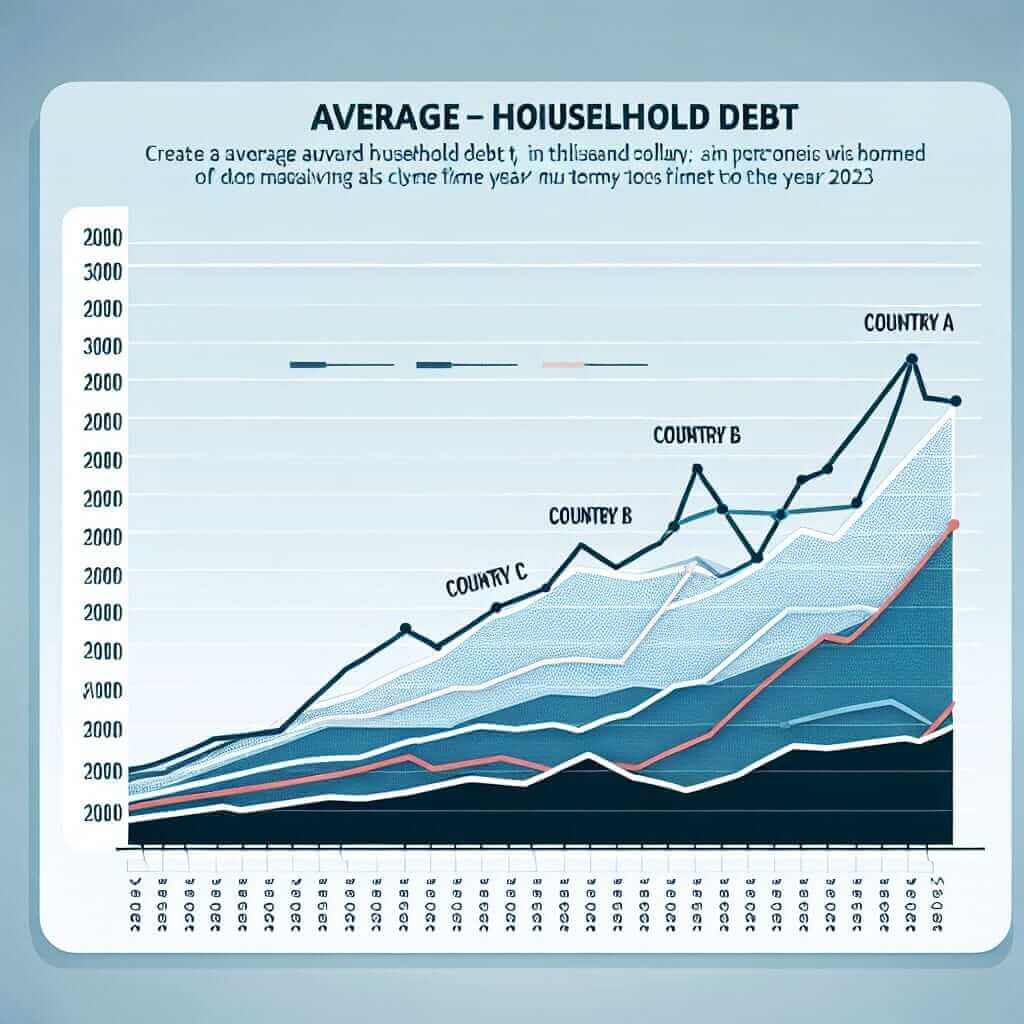Understanding the trends related to “Average Household Debt in Various Countries (2000-2023)” can be a common topic in the IELTS Writing Task 1. This type of topic frequently appears in the form of charts, graphs, or tables, requiring test-takers to describe and analyze the given data.
Sample Task:
You should spend about 20 minutes on this task.
The chart below shows the average household debt in various countries from the year 2000 to 2023. Summarize the information by selecting and reporting the main features, and make comparisons where relevant.
Write at least 150 words.
Analyzing the Task
Let’s examine a hypothetical chart depicting the average household debt from 2000 to 2023 in three countries: Country A, Country B, and Country C. The numbers are expressed in thousands of dollars ($’000).
| Year | Country A | Country B | Country C |
|---|---|---|---|
| 2000 | 30 | 45 | 50 |
| 2005 | 35 | 50 | 55 |
| 2010 | 40 | 55 | 60 |
| 2015 | 45 | 60 | 65 |
| 2020 | 50 | 65 | 70 |
| 2023 | 55 | 70 | 75 |

Sample Answer
The table illustrates the average household debt in thousands of dollars across three different countries, namely Country A, Country B, and Country C, over the period from 2000 to 2023.
Overall, it is evident that the household debt in all three nations has shown an upward trend throughout the years. Among the three, Country C consistently maintained the highest amount of debt, while Country A had the lowest debt levels.
In 2000, Country C started with the highest average household debt at $50,000, followed closely by Country B at $45,000 and Country A at $30,000. By 2010, the debt in Country C had risen moderately to $60,000, whereas Country B saw a similar increase reaching $55,000, and Country A reported a rise to $40,000.
Between 2010 and 2023, there was a noticeable growth in household debt in all countries. Country C’s debt rose to $75,000 by 2023, marking a $25,000 increase over the 23-year period. Country B also experienced a significant rise, reaching $70,000 in 2023, up $25,000 from 2000. Country A, while having the least debt, showed a steady increase each year and culminated at $55,000 by 2023.
In summary, the average household debt in all three countries has been on a consistent rise, with Country C always having the largest amount of debt, and Country A, the smallest.
Word Count: 227
Important Notes for Writing
Vocabulary and Grammar Considerations
-
Vocabulary Related to Trends and Comparisons:
- Upward trend: “rise”, “increase”, “growth”
- Consistency: “steady”, “consistent”
- Comparison: “highest”, “lowest”, “more than”, “less than”, “similar increase”
-
Complex Sentences:
- Use subordinating conjunctions: “whereas”, “while”, “although”
- Use relative clauses: “which saw a similar increase”
Important Vocabulary
- Debt (n.) /det/: The amount of money borrowed by households.
- Trend (n.) /trend/: A general direction in which something is developing or changing.
- Consistent (adj.) /kənˈsɪs.tənt/: Steady and regular over a period of time.
- Moderate (adj.) /ˈmɒd.ər.ət/: Average in amount, intensity, quality, or degree.
- Noticeable (adj.) /ˈnəʊ.tɪ.sə.bəl/: Easily seen or noticed; clear or apparent.
Key Points for Scoring High
- Accuracy and Clarity: Accurately report the given data and make clear comparisons.
- Varied Sentence Structure: Use a mix of simple, compound, and complex sentences to demonstrate range.
- Relevant Vocabulary: Employ topic-specific vocabulary accurately and appropriately.
- Coherence and Cohesion: Ensure your writing is logically organized with clear connections between ideas.
Conclusion
Successfully handling a task like the one on “Average Household Debt in Various Countries (2000-2023)” involves accurate data description, proper use of comparison and trend vocabulary, and clear organization. Practice these skills regularly to aim for a high band score in the IELTS Writing Task 1.